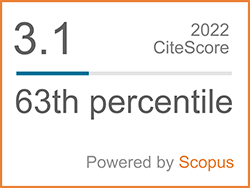Enhancement of CO2 Adsorption Containing Zinc-ion-exchanged Zeolite NaA Synthesized from Rice Husk Ash
Abstract
Carbon dioxide is main causes the greenhouse effect and it contributes to global warming. Zeolite NaA is an excellent adsorbent among other materials but its potential as a carbon dioxide adsorption still needs to be developed. Therefore, this research was to synthesize zeolite NaA from rice husk ash under different temperatures and crystallization times. The synthesized zeolite NaA was modified with zinc by an ion exchange method. Adsorbents were tested for the carbon dioxide adsorption at different operating temperatures and flow rates. The results showed that the zeolite NaA was successfully synthesized from rice husk ash under optimal conditions of the crystallization temperature at 333.15 K and time for 2 h. The zeolite NaA can be synthesized at low crystallization temperature and time resulted in this adsorbent has low cost while achieving high efficiency. The results of zeolite NaA modification with zinc playing a key role to increase the BET surface area, micropore volume and total pore volume resulted in an increase of carbon dioxide adsorption capacity. High carbon dioxide adsorption at 89.08% with the operating temperature at 573.15 K and carbon dioxide flow rate of 1 L/h were shown with 5 wt.% zeolite NaA.
Keywords
[1] Y. Wang, T. Du, Z. Qiu, Y. Song, S. Che, and X. Fang, “CO2 adsorption on polyethyleniminemodified ZSM-5 zeolite synthesized from rice husk ash,” Materials Chemistry and Physics, vol. 207, pp. 105–113, 2018.
[2] M. Vinoba, M. Bhagiyalakshmi, Y. Alqaheem, A. A. Alomair, A. Pérez, and M. S. Rana, “Recent progress of fillers in mixed matrix membranes for CO2 separation: A review,” Separation and Purification Technology, vol. 188, pp. 431–450, 2017.
[3] Energy Policy and Planning office (EPPO), “Carbon dioxide (CO2) emissions from energy consumption in 2019,” Energy Policy and Planning office (EPPO), Ministry of Energy, Bangkok, Thailand.
[4] H. Liu, G. Qiu, Y. Shao, and S. B. Riffat, “Experimental investigation on flue gas emissions of a domestic biomass boiler under normal and idle combustion conditions,” International Journal of Low-Carbon Technologies, vol. 5, pp. 88–95, 2010.
[5] B. Acar, M. S. Başar, B. M. Eropak, B. S. Caglayan, and A. E. Aksoylu, “CO2 adsorption over modified AC samples: A new methodology for determining selectivity,” Catalysis Today, vol. 301, pp. 112–124, 2018.
[6] P. Ammendola, F. Raganati, and R. Chirone, “CO2 adsorption on a fine activated carbon in a sound assisted fluidized bed: Thermodynamics and kinetics,” Chemical Engineering Journal, vol. 322, pp. 302–313, 2017.
[7] S. Y. Lee and S. J. Park, “A review on solid adsorbents for carbon dioxide capture,” Journal of Industrial and Engineering Chemistry, vol. 23, pp. 1–11, 2015.
[8] M. Younas, M. Sohail, L. K. Leong, M. J. K. Bashir, and S. Sumathi, “Feasibility of CO2 adsorption by solid adsorbents: A review on low-temperature systems,” International Journal of Environmental Science and Technology, vol. 13, pp. 1839–1860, 2016.
[9] Q. Jiang, J. Rentschler, G. Sethia, S. Weinman, R. Perrone, and K. Liu, “Synthesis of T-type zeolite nanoparticles for the separation of CO2/N2 and CO2/CH4 by adsorption process,” Chemical Engineering Journal, vol. 230, pp. 380–388, 2013.
[10] Z. Bacsik, O. Cheung, P. Vasiliev, and N. Hedin, “Selective separation of CO2 and CH4 for biogas upgrading on zeolite NaKA and SAPO-56,” Applied Energy, vol. 162, pp. 613–621, 2016.
[11] L. Yu, J. Gong, C. Zeng, and L. Zhang, “Synthesis of binderless zeolite X microspheres and their CO2 adsorption properties,” Separation and Purification Technology, vol. 118, pp. 188–195, 2013.
[12] R. M. Mohamed, I. A. Mkhalid, and M. A. Barakat, “Rice husk ash as a renewable source for the production of zeolite NaY and its characterization,” Arabian Journal of Chemistry, vol. 8, pp. 48–53, 2015.
[13] S. Salehi and M. Anbia, “Characterization of CPs/Ca-exchanged FAU- and LTA-type zeolite nanocomposites and their selectivity for CO2 and N2 adsorption,” Journal of Physics and Chemistry of Solids, vol. 110, pp. 116–128, 2017.
[14] H. Yi, H. Deng, X. Tang, Q. Yu, X. Zhou, and H. Liu, “Adsorption equilibrium and kinetics for SO2, NO, CO2 on zeolites FAU and LTA,” Journal of Hazardous Materials, vol. 203–204, pp. 111–117, 2012.
[15] A. R. Loiola, J. C. R. A. Andrade, J. M. Sasaki, and L. R. D. da Silva, “Structural analysis of zeolite NaA synthesized by a cost-effective hydrothermal method using kaolin and its use as water softener,” Journal of Colloid and Interface Science, vol. 367, pp. 34–39, 2012.
[16] W. Panpa and S. Jinawath, “Synthesis of ZSM-5 zeolite and silicalite from rice husk ash,” Applied Catalysis B: Environmental, vol. 90, pp. 389–394, 2009.
[17] I. J. Fernandes, D. Calheiro, F. A. L. Sánchez, A. L. D. Camacho, T. L. A. C. Rocha, C. A. Moraes, and V. C. Sousa, “Characterization of silica produced from rice husk ash: Comparison of purification and processing methods,” Journal of Materials Research, vol. 20, pp. 512–518, 2017.
[18] M. Mirfendereski and T. Mohammadi, “Effects of synthesis parameters on the characteristics of Naa type zeolite nanoparticles,” in Proceedings of the World Congress on Recent Advances in Nanotechnology (RAN’16), 2016, pp. ICNNFC 113.
[19] A. A. B. Maia, R. N. Dias, R. S. Angélica, and R. F. Neves, “Influence of an aging step on the synthesis of zeolite NaA from Brazilian Amazon kaolin waste,” Journal of Materials Research and Technology, vol. 8, pp. 2924–2929, 2019.
[20] S. N. Azizi and M. Yousefpour, “Synthesis of zeolites NaA and analcime using rice husk ash as silica source without using organic template,” Journal of Materials Science, vol. 45, pp. 5692– 5697, 2010.
[21] T. Farías, L. C. de Ménorval, O. Picazo, and R. Jordán, “Ultrasonic and conventional synthesis of NaA zeolite from rice husk ash,” Journal of Physics: Conference Series 792, pp. 1–9, 2017.
[22] A. R. Loiola, J. C. R. A. Andrade, J. M. Sasaki, and L. R. D. da Silva, “Structural analysis of zeolite NaA synthesized by a cost-effective hydrothermal method using kaolin and its use as water softener,” Journal of Colloid and Interface Science, vol. 367, pp. 34–39, 2012.
[23] E. Diaz, E. Munoz, A. Vega, and S. Ordonez, “Enhancement of the CO2 retention capacity of X zeolites by Na- and Cs-treatments,” Chemosphere, vol. 70, pp. 1375–1382, 2008.
[24] R. Kodasma, J. Fermoso, and A. Sanna, “Li- LSX-zeolite evaluation for post-combustion CO2 capture,” Chemical Engineering Journal, vol. 358, pp. 1351–1362, 2019.
[25] P. Worathanakul and N. Rakpasert, “Different preparation methods of Ni-FAU(Y) zeolite for nitric oxide reduction,” International Journal of Chemical Engineering and Applications, vol. 10, no. 4, pp. 106–109, 2019.
[26] P. Worathanakul and P. Saisuwansiri, “Effect of copper and iron loading on zeolite Y for carbon dioxide adsorption,” The Journal of King Mongkut's University of Technology North Bangkok, vol. 28, pp. 373–381, 2017.
[27] S. J. Chen, M. Zhu, Y. Fu, Y. X. Huang, Z. C. Tao, and W. L. Li, “Using 13X, LiX, and LiPdAgX zeolites for CO2 capture from post-combustion flue gas,” Applied Energy, vol. 191, pp. 87–98, 2017.
[28] E. Nyankson, J. K. Efavi, A. Yaya, G. Manu, K. Asare, J. Daafuor, and R. Y. Abrokwah, “Synthesis and characterisation of zeolite-A and Zn-exchanged zeolite-A based on natural aluminosilicates and their potential applications,” Cogent Engineering, vol. 5, pp. 1–23, 2018.
[29] D. Smykowski, B. Szyja, and J. Szczygieł, “DFT modeling of CO2 adsorption on Cu, Zn, Ni, Pd/ DOH zeolite,” Journal of Molecular Graphics and Modelling, vol. 41, pp. 89–96, 2013.
[30] D. Esquivel, A. J. Cruz-Cabeza, C. Jiménez- Sanchidrián, and F. J. Romero-Salguero, “Transition metal exchanged β zeolites: Characterization of the metal state and catalytic application in the methanol conversion to hydrocarbons,” Microporous and Mesoporous Materials, vol. 179, pp. 30–39, 2013.
[31] D. An, Y. Guo, Y. Zhu, and Z. Wang, “A green route to preparation of silica powders with rice husk ash and waste gas,” Chemical Engineering Journal, vol. 162, pp. 509–514, 2010.
[32] O. Cheung, Z. Bacsik, Q. Liu, A. Mace, and N. Hedin, “Adsorption kinetics for CO2 on highly selective zeolites NaKA and nano-NaKA,” Applied Energy, vol. 112, pp. 1326–1336, 2013.
[33] P. Worathanakul, N. Klinpol, and T. Sarai, “Innovation of CO2 adsorption with Li/zeolite A derived from bagasse ash,” in Proceeding of Universal Academic Cluster International Spring Conference in Osaka, 2017, pp. 97–102.
[34] C. A. Grande, H. Kvamsdal, G. Mondino, and R. Blom, “Development of moving bed temperature swing adsorption (MBTSA) process for postcombustion CO2 capture: Initial benchmarking in a NGCC context,” Energy Procedia, vol. 114, pp. 2203–2210, 2017.
[35] K. A. Matori, M. M. Haslinawati, Z. A. Wahab, H. A. A. Sidek, T. K. Ban, and W. A. W. A. K. Ghani, “Producing amorphous white silica from rice husk,” MASAUM Journal of Basic and Applied Sciences, vol. 1, pp. 512–515, 2009.
[36] X. Jin, N. Jia, C. Song, D. Ma, G. Yan, and Q. Liu, “Synthesis of CHA zeolite using low cost coal fly ash,” Procedia Engineering, vol. 121, pp. 961–966, 2015.
[37] X. W. Cheng, Q. Y. Meng, J. Y. Chen, and Y. C. Long, “A facile route to synthesize mesoporous ZSM-5 zeolite incorporating high ZnO loading in mesopores,” Microporous and Mesoporous Materials, vol. 153, pp. 198–203, 2012.
[38] K. Ramasubramanian, M. A. Severance, P. K. Dutta, and W. S. W. Ho, “Fabrication of zeolite/ polymer multilayer composite membranes for carbon dioxide capture: Deposition of zeolite particles on polymer supports,” Journal of Colloid and Interface Science, vol. 452, pp. 203–214, 2015.
[39] S. I. Garcés-Polo, J. Villarroel-Rocha, K. Sapag, S. A. Korili, and A. Gil, “Adsorption of CO2 on mixed oxides derived from hydrotalcites at several temperatures and high pressures,” Chemical Engineering Journal, vol. 332, pp. 24–32, 2018.
[40] Y. Wang, T. Du, Z. Qiu, Y. Song, S. Che, and X. Fang, “CO2 adsorption on polyethyleniminemodified ZSM-5 zeolite synthesized from rice husk ash,” Materials Chemistry and Physics, vol. 207, pp. 105–113, 2018.
[41] G. D. Pirngruber, V. Carlier, and D. Leinekugel-le Cocq, “Post-combustion CO2 capture by vacuum swing adsorption using zeolites – A feasibility study,” Oil & Gas Science and Technology, vol. 69, pp. 989–1003, 2014.
[42] Y. Cho, J. Y. Lee, A. D. Bokare, S. B. Kwon, D. S. Park, W. S. Jung, J. S. Choi, Y. M. Yang, J. Y. Lee, and W. Choi, “LiOH-embedded zeolite for carbon dioxide capture under ambient conditions,” Journal of Industrial and Engineering Chemistry, vol. 22, pp. 350–356, 2015.
DOI: 10.14416/j.asep.2020.11.006
Refbacks
- There are currently no refbacks.






.png)



